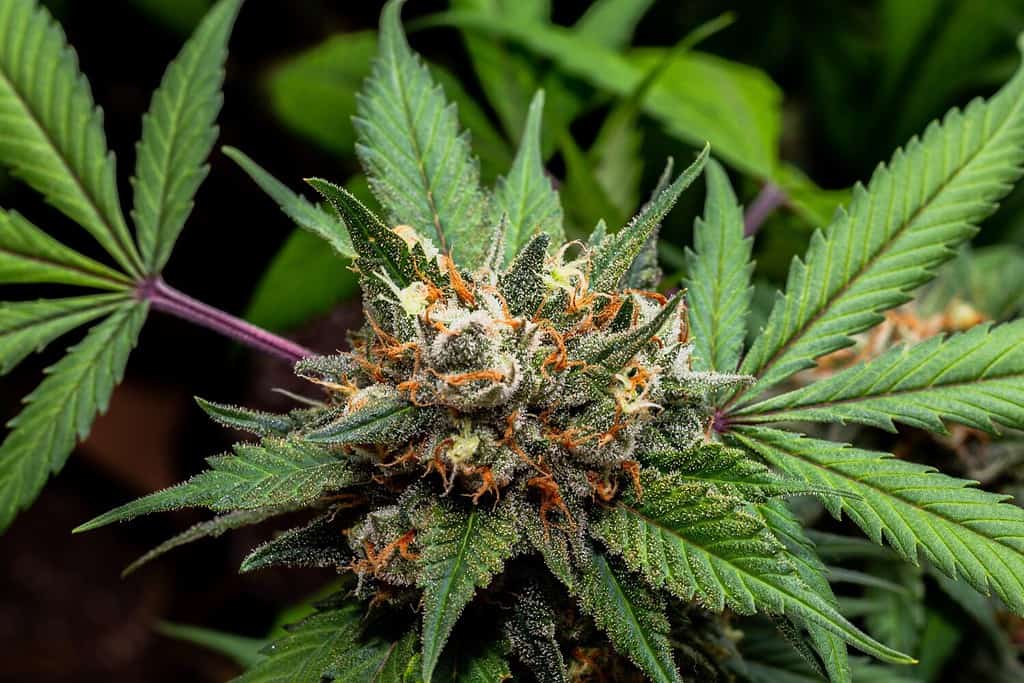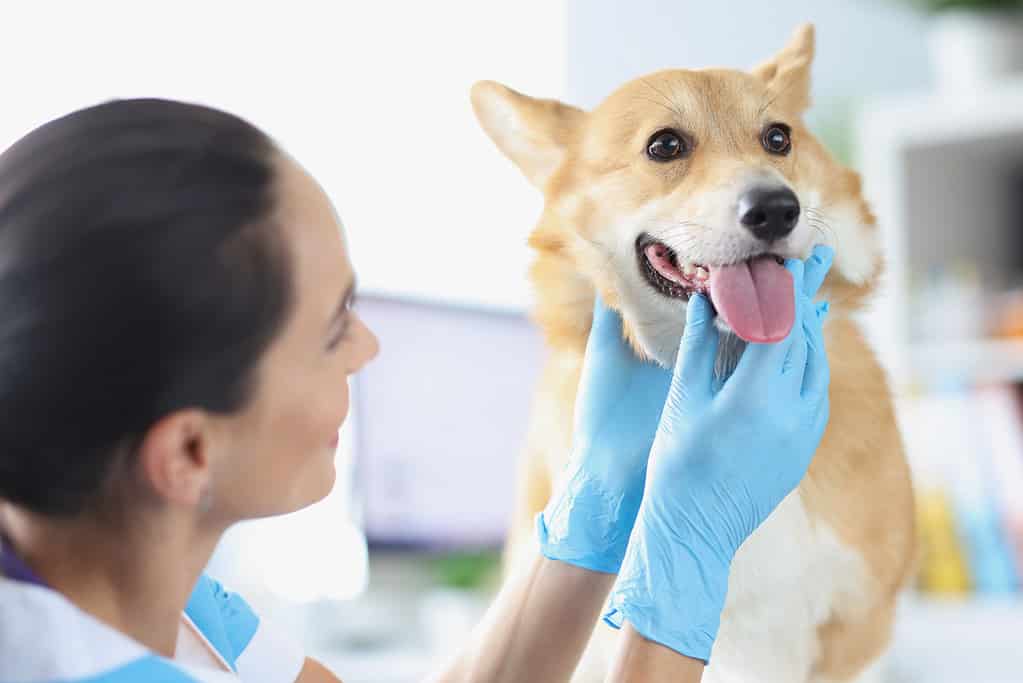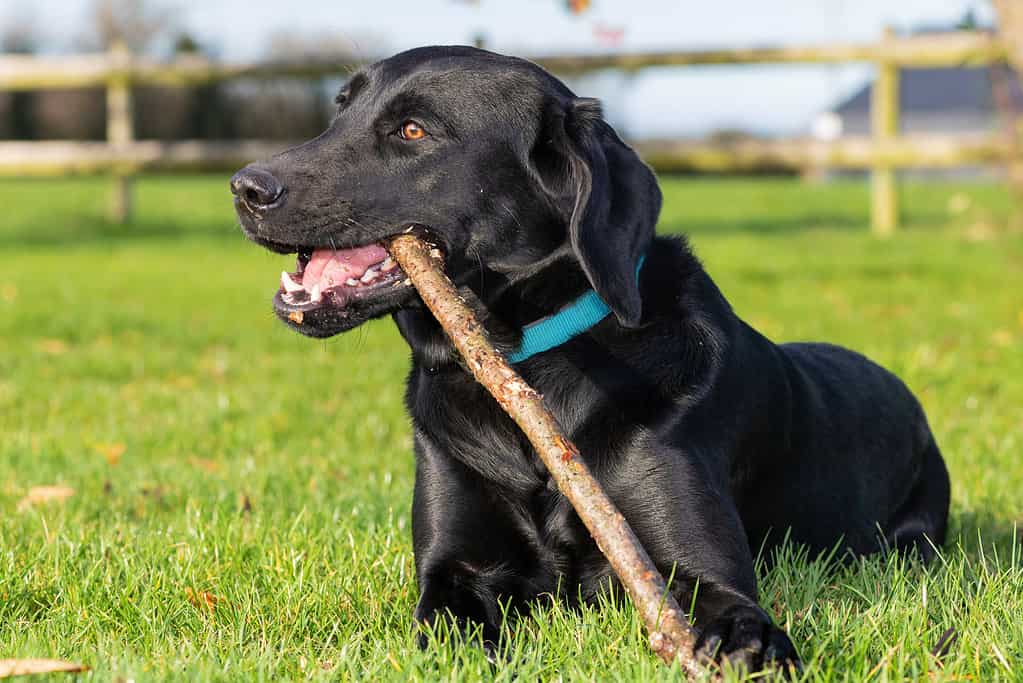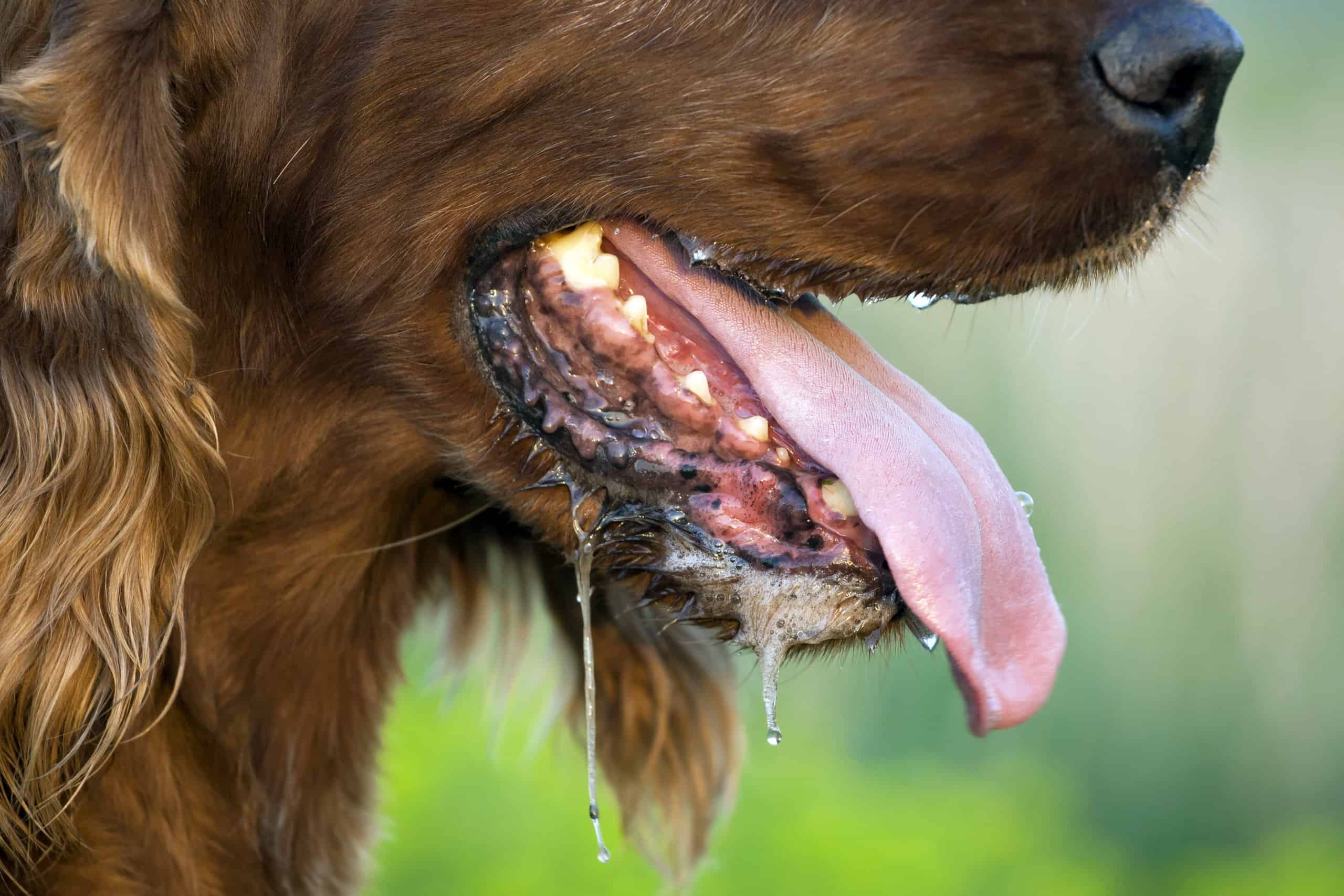Cannabis (also called marijuana, pot, dope, or weed) is a recreational drug. Opinions on its benefits and risks to humans differ. The effect that it has on dogs, however, is not up for debate. Cannabis poisoning in dogs is a serious health issue and the incidence is increasing. Here we take a close look at how cannabis affects dogs, how they become exposed to it, and what you can do to reduce the risk for your pet.
What Exactly Is Cannabis?

Cannabis plants contain more than 100 different compounds which are called cannabinoids.
©Kaylin Colette/Shutterstock.com
Cannabis is essentially the dried leaves, flowers, stems, leaves, or seeds of the cannabis plant. They can be smoked like a cigarette, vaped using electronic vaporizing devices, or ingested in food or drink.
Within the plant, there are more than 100 different compounds which are called cannabinoids. The most widely understood is delta-9 tetrahydrocannabinol (THC) which has psychoactive (mind-altering) properties in humans.
Why Is Cannabis Poisonous for Dogs?
Humans and dogs are both mammals and we both have receptors (called cannabinoid receptors) in the plasma membranes of brain cells. THC can attach to these receptors and this enables it to affect our bodies. In humans, we call this a ‘high’. The problem is that dogs have more of these receptors than we do and they are distributed differently in the brain. Instead of experiencing a high they are poisoned.
Also, a dog’s body recirculates THC. They absorb it and store it in bile. This is a fluid made in the liver that discharges via the bile duct into the intestines when the dog eats. So, when your dog ingests their next meal, the bile containing THC is secreted into their intestines and they get exposed all over again.
How Are Dogs Exposed to THC?
There are numerous ways in which dogs can be exposed to THC in your home or when they are out and about. Here are the main routes of exposure that we know about so far:
- Eating any part of a fresh growing cannabis plant.
- Eating edibles – baked or manufactured goods such as cakes, cookies, or candies.
- Drinking herbal preparations containing cannabis.
- Eating cannabis in discarded joints (cigarettes) or blunts (cigars refilled with cannabis).
- Chewing bongs (pipes containing cannabis).
- Swallowing cannabis in capsules.
- Licking cannabis butter.
- Passive (secondhand) smoking.
- Chewing on electronic vaporizing devices (vapes).
- Eating feces (poop) of a cannabis user – around 65 percent of the cannabis that a human ingests is excreted in their feces.
Why Are Edibles So Dangerous?

Baked goods containing cannabis are often implicated in dog poisoning.
©Mark R Coons/Shutterstock.com
The first reason is that dogs are highly attracted to foods such as cookies and cakes. Also, these goods are often made with oil or butter that is used to extract THC from plant material. They therefore contain higher levels of THC than the natural plant leaves and stems. This makes them more dangerous.
Furthermore, chocolate, raisins, and xylitol are commonly added to these sorts of baked goods. All of these are toxic for dogs and so the poor animal gets a double dose of poison. Dogs poisoned in this way have the poorest prognosis.
Why Do Dogs Eat Human Poop?

Some dogs eat their poop and the poop of other animals!
©Uryupina Nadezhda/Shutterstock.com
Sadly, dogs are attracted to things that we find disgusting! This is why they can often be found rolling in the poop of many different species including foxes. You may also find your pet dog feasting on cat poop from a litter tray, eating their poop, or that deposited by other dogs. This behavior is called coprophagia and probably relates to a dog’s ancestry as a scavenger. They are used to having to grab any sort of nutrient where they can get them. Unfortunately, this includes the feces of other species.
Can Other Animals Suffer Cannabis Poisoning?
Cannabis is also toxic to cats and horses. However, the incidence of poisoning in these animals is much lower. This is probably because cats and horses do not scavenge in the same way as dogs do. Many dogs have a reputation for eating anything that they come across and this is not the case for cats and horses.
How Much Cannabis Is Safe for Dogs?
There is no safe level of cannabis exposure for dogs. The LD50 is the standard measurement of how toxic a substance is for a given animal. LD stands for ‘Lethal Dose’. LD50 is the amount of a material, given all at once, which causes the death of 50 percent (one-half) of a group of test animals. This has not yet been calculated for cannabis exposure in dogs.
All dogs are different and not all dogs process cannabis in the same way. A small amount of cannabis may hardly affect one dog but can have a serious effect on another. The exact impact on your dog will depend on its age, its health status, and its body size but there are many other complicating factors.
How Long Does It Take for Cannabis to Poison a Dog?
Again, this is variable and depends on the route of exposure. If the substance is inhaled, it can start to cause an effect within minutes. When it is ingested, most dogs start to show some symptoms between 30 minutes and an hour of exposure but it can be up to three hours. In a few cases, it has taken 12 hours for the symptoms to become apparent.
How Can You Spot Dog Has Cannabis Poisoning?
Dogs suffering from cannabis poisoning will usually have both neurological and physical symptoms. The symptoms are very obvious and it is clear that there is something wrong with the dog.
In terms of neurological effects, it is typical for the dog to look wobbly and uncoordinated. The medical term for this is ataxia. When they try to walk, they often cross one leg over another and look as if they are drunk. Some dogs become hyperactive, but others become sleepy and disorientated and some can be very vocal. Others become extremely sensitive to touch and pressure (hyperesthesia). Some dogs are increasingly sensitive to sound and motion and may flinch easily. The pupils may be dilated (mydriasis) which them a wide-eyed appearance and they may drool excessively (ptyalism). They may also have a repetitive involuntary movement of their eyes from side to side (nystagmus). Severely affected animals can develop tremors and seizures and may fall into a coma.
Physical signs often include a slow heart rate (bradycardia) but less commonly the dog’s heart rate may be fast (tachycardia). Their blood pressure may drop (hypotension), their body temperature may fall (hypothermia), and their respiratory rate may also fall (bradypnea). Often dogs develop urinary incontinence and some vomit.
The clip below shows a dog with typical symptoms.
What Should You Do if Your Dog Has Cannabis Poisoning?
Any sort of poisoning in dogs requires immediate veterinary attention. If you suspect that your dog has cannabis poisoning, do not assume that they will be able to sleep it off because this is not the case. They require immediate diagnosis and appropriate treatment to limit the effects of the poisoning and to help them recover. Your dog requires an emergency appointment, not a regular appointment, and warn your vet that you think that your dog may have been poisoned.
You mustn’t try to make your dog sick. This should only be done by a qualified vet because it can result in ulceration of the esophagus (food pipe). It can also result in your dog accidentally inhaling their vomit which is called aspiration pneumonia which is a life-threatening condition.
How Long Does It Last?
Because THC is stored in your dog’s fat deposits, it can take several days for the effects to wear off. Also, the recirculation via the liver (enterohepatic recirculation) can increase the duration. Most dogs are feeling a lot better within 24 hours, but the clinical signs can last for 96 hours. In general, vets find that dogs exposed to eating edibles have symptoms that last the longest.
Diagnosing Cannabis Poisoning in Dogs

Dogs with suspected poisoning need to be seen by a vet immediately.
©megaflopp/iStock via Getty Images
1. Information
If you know that your dog has consumed some cannabis products in your home, you must be honest about this with your vet. It will drastically cut down the time needed to make a diagnosis and will increase your dog’s chances of making a full recovery.
If you have noticed symptoms but do not know what they have ingested, there is still a lot that you can tell your vet. For example, have you just returned from a walk, and was your dog out of your sight for any period during which it may have consumed some cannabis? Alternatively, did you see your dog emerging from some bushes with a guilty look on its face? It probably found something to eat there! All of this is important information that your vet needs to know.
2. Examination
Most THC toxicosis diagnoses are made by the vet examining your pet. Urine dribbling in particular is highly indicative of THC toxicosis and is not caused by many other chemicals. The other symptoms can sometimes be caused by alcohol poisoning and by the ingestion of other human medication including tranquilizers.
3. Tests
Your vet will be able to test for THC in your dog’s urine. However, these tests do sometimes give false negatives, so a negative test does not mean that they were not poisoned. This is more likely to happen if the test is run too soon after exposure. Therefore, your vet also uses the results of a clinical examination to make a diagnosis.
How Is Marijuana Poisoning in Dogs Treated?
The exact treatment will depend on the symptoms that your dog is showing, how long it has been since they were exposed to cannabis, and how they were exposed. Inhalation cases may require support for respiratory inhalation. If they have eaten a cannabis product, your vet may try to induce vomiting to eliminate what is left in their stomach. Unfortunately, cannabis can have the effect of subduing nausea and it can make it difficult to make a dog vomit. Also, if the dog is very sleepy, inducing vomiting can be dangerous because it can lead to aspiration pneumonia.
The other option for removing large amounts of cannabis-containing material from the stomach is called gastric lavage. The common name for this is ‘stomach pumping’ and it essentially involves inserting a tube into your dog’s stomach and flushing it out under very carefully controlled conditions. If the cannabis product has already passed into the small intestine from the stomach then it is too late for this treatment.
On the plus side, by making the dog vomit it may be possible to see exactly what they have eaten that has caused the problem in the first place. This is useful for the owner to know and can help them to prevent it from happening again.
Another treatment option is activated charcoal. This is a liquid material that is given orally. It traps the THC in the charcoal so that it is not absorbed in the intestine and passes out of the body in the feces. Again, this works better if the cannabis poisoning has only just happened. Also, multiple doses may be given at eight-hour intervals to help with the recirculation of THC via bile.
Supportive Care for Cannabis Poisoning

Dogs with cannabis poisoning may need help to keep warm.
©marialevkina/Shutterstock.com
Most dogs are hospitalized because they require intravenous fluids and very careful monitoring of their electrolytes during this treatment. There are various drug treatments to tackle other symptoms including abnormal heart rates. Some dogs need help with controlling their blood pressure and maintaining organ function. Other dogs need medication to calm anxiety.
Many dogs with cannabis poisoning need help to regulate their body temperature so they will be kept in a warm place.
What Is the Prognosis?
Most dogs will make a full recovery. It’s not a particularly pleasant experience for them but they have no long-term effects. The quicker you can get them to the vet, the more positive the outcome is likely to be. However, fatalities have been recorded. Dogs are more likely to die if they have secondary complications such as toxicity from other ingredients in edibles. If they aspirate their vomit this is also more dangerous. If they fall into a coma, their chances of survival are decreased.
How to Prevent Cannabis Poisoning in Dogs
The bottom line in preventing cannabis poisoning in dogs is to stop them from being exposed in the first place. If you are a cannabis user yourself, it is your responsibility to keep anything associated with cannabis out of reach of your pet. You may want to think about storing them in high cabinets or locked drawers. If you are smoking cannabis, do so in a well-ventilated room and keep your dog in another part of the house. Remove all traces of edibles after you have ingested them including the wrapping.
Close supervision of your dog is also important especially if you have a breed who likes to poke around bushes and eat what they find there. Some owners use a gauze muzzle to try to stop their dogs from ingesting foreign substances when they are walking in urban areas. Teaching the ‘leave it’ command can also prevent anything inappropriate from being consumed by your dog!
Which Dogs Are Most Likely to Get Poisoned

Any dog that likes to eat things they find on the ground is at risk of poisoning.
©iStock.com/Tom Meaker
Interestingly, some research has shown that dogs living in urban areas are more likely to suffer from this form of poisoning. Also, smaller and intact male dogs may be more at risk. Any dog that has a habit of eating whatever they found on the ground is more likely to get any form of poisoning. Labrador owners and some spaniel owners will be only too familiar with this habit!
Are Synthetic Cannabinoids Dangerous for Dogs?
Synthetic cannabinoids (including the drug known as ‘spice’) are used by some people as an alternative to marijuana. We know that they can be toxic to humans and can cause rapid heart rates, vomiting, confusion, and hallucinations. They are either sprayed on dried plant material and smoked in cigarettes or sold as liquid to be used in inhalant devices. These products are far more likely to cause serious toxicosis in dogs.
In these cases, dogs typically suffer more severe symptoms that include sensitivity and
aggression as well as tremors, and seizures. Synthetic cannabinoids are not detected by urine THC tests making diagnosis more difficult.
Is Cannabis Poisoning in Dogs Increasing?
There is evidence that cannabis poisoning in dogs is increasing in several countries. In the US, one study found a correlation between the number of medical marijuana licenses issued and the incidence of marijuana toxicosis in dogs. Another survey of vets in North America has concluded that the recent legalization of cannabis has coincided with an increase in the diagnosis of cannabis-induced toxicosis in pets. The survey was conducted in 2021 and covered a sample of practices in both Canada and the US. However, it is not clear if this is a true increase or if it is just an increase in reporting as the legal status of the drug has changed. A further study has shown that consultations for dog cannabis poisoning are significantly higher in US states with lower penalties for cannabis use and possession.
Media reports from the UK indicate that the incidence is also increasing there. This has even prompted some police authorities to issue warnings on social media.
Are CBD Oil Pet Products Dangerous?

Some owners use CBD oil for dog anxiety.
©iStock.com/Vanessa Nunes
CBD (cannabidiol) pet products should not contain any THC. CBD oil is popular amongst some dog owners for treating several conditions including anxiety, pain, and seizures. There is currently little scientific data proving that it is useful. We also don’t know if it can interact with veterinary medications. Also, its manufacture and distribution are not rigorously regulated. Therefore, there is a possibility that some CBD products could contain small amounts of THC. You should always check with your vet before administering any type of medication to your dog. Laws governing these products are constantly changing so you should also check the legal position in the area where you live. The American Veterinary Medical Association state that ‘Federal and state laws regarding cannabis products are complex, and the legal landscape around these products is evolving’.
Summing up Cannabis Poisoning in Dogs
Cannabis poisoning in dogs occurs when they inhaul, or more commonly ingest, cannabis in products designed for humans including edibles, or if they eat the feces of a cannabis user. Dogs have lots of cannabinoid receptors in their brain so the active substances in cannabis, such as THC, have more effect. The signs are a loss of coordination, excessive drooling, and dribbling urine. If these dogs receive immediate medical attention the prognosis is good and most recover within 48 hours but deaths have occurred.
Synthetic cannabinoids are even more toxic and dogs who become ill from eating cannabis-containing baked products are more at risk because they often contain other poisons. Owners can help to prevent it by storing all cannabis-containing products securely and by keeping a close eye on their dogs when on walks.
Ready to discover the top 10 cutest dog breeds in the entire world?
How about the fastest dogs, the largest dogs and those that are -- quite frankly -- just the kindest dogs on the planet? Each day, AZ Animals sends out lists just like this to our thousands of email subscribers. And the best part? It's FREE. Join today by entering your email below.
Thank you for reading! Have some feedback for us? Contact the AZ Animals editorial team.








